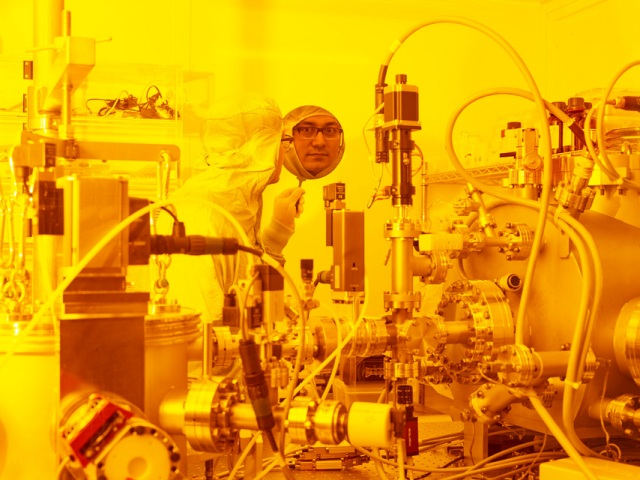Jul 6 2015
Researchers reveal how particularly fine structures can be produced in semiconductors for computer chips of the future
The production of increasingly more rapid and efficient computers and smartphones requires increasingly smaller components in the computer chips used, such as wiring or transistors. This poses a constant challenge for the technologies used to produce these components inside the chips. Scientists from the Paul Scherrer Institute (PSI) have now succeeded in reaching another important milestone here: they have created a regular pattern of parallel lines in a semiconductor material that are seven nanometres wide (one nanometre is a millionth of a millimetre) – equivalent to a component arrangement that is sixteen times denser than in today’s chips. Industry envisages structures on this scale as the standard by the year 2028. The lines were created with EUV (extreme ultraviolet) light at the Paul Scherrer Institute’s Swiss Light Source (SLS).
 PSI researcher Yasin Ekinci next to the XIL-II beamline at the Swiss Light Source (SLS), where the fine structures needed for electronic components of the future are produced in a semiconductor material. To this end, Ekinci and her team used extreme ultraviolet light (EUV) with a wavelength of 13.5 nanometres. (Photo: Scanderbeg Sauer Photography)
PSI researcher Yasin Ekinci next to the XIL-II beamline at the Swiss Light Source (SLS), where the fine structures needed for electronic components of the future are produced in a semiconductor material. To this end, Ekinci and her team used extreme ultraviolet light (EUV) with a wavelength of 13.5 nanometres. (Photo: Scanderbeg Sauer Photography)
Semiconductor technology paved the way for the digital revolution. It has been instrumental in changing our lifestyle in the last few decades and will continue to do so in the foreseeable future, too. As predicted in Moore’s Law half a century ago, the semiconductor industry made this revolution possible by developing more compact, efficient and rapid electronics, which can be produced at increasingly lower costs. An intrinsic part of this was the progress achieved in production techniques and the development of novel concepts for the construction of electronic components. Here, the individual components of modern computer chips – such as wiring or transistors – are not soldered on as separate parts, but rather produced as fine structures within the silicon wafer, which forms the basis for the chip. The semiconductor industry’s long-term planning includes producing chips with structures that are smaller than twenty nanometres and where the components are arranged three-dimensionally. These ambitious plans pose an enormous challenge for the production processes.
In the crosshairs: the electronics of 2028
Researchers from the Paul Scherrer Institute have now succeeded in producing a regular pattern of parallel lines in a semiconductor material that are merely seven nanometres wide. Structures of this size are planned as the industry standard for computer chips by 2028. One nanometre is a millionth of a millimetre. Seven nanometres is equivalent to the size of single, larger molecules in our cells, the smallest viruses are fifteen nanometres in size and bacteria are considerably larger. The researchers used photolithography at the Swiss Light Source (SLS) to create the thin lines – a technique that enables very fine structures to be generated rapidly by covering the material to be processed with a thin, light-sensitive layer. The structure is then projected onto this layer with light, thereby altering the properties of the layer at the points illuminated. As with a film in traditional photography, the layer is then developed and the illuminated parts removed. The pattern projected can subsequently be etched into the semiconductor material using a special process. During the production of electronic components, such as memory or CPU chips, this process is repeated several times to develop complex structures with billions of transistors.
Short wavelength at PSI for the semiconductors of the future
The finer the structures to be produced with photolithography, the smaller the wavelength of the light used needs to be. As a result, these wavelengths have gradually become smaller and smaller over the decades – beginning with visible light (wavelength of 400 to 700 nanometres) all the way to the deep ultraviolet with a wavelength of 193 nanometres used by industry today. For the next generation of lithography, industry envisages the use of extreme ultraviolet (EUV) with a wavelength of 13.5 nanometres. The PSI researchers used this kind of light at the SLS to produce their fine structures. The results reveal that the semiconductor industry’s plans are actually feasible and that PSI offers a unique infrastructure to research this undertaking. The semiconductor industry and its suppliers therefore use these research possibilities extensively. PARK innovAARE, which is currently being developed as a location for Switzerland’s innovation park right on PSI’s doorstep, will provide new possibilities for close collaborations between PSI and the industry. The establishment of industrial companies at PARK innovAARE will enable an intensive exchange between PSI and these companies, from which both sides stand to benefit.
Text: Paul Scherrer Institut/Yasin Ekinci and Paul Piwnicki